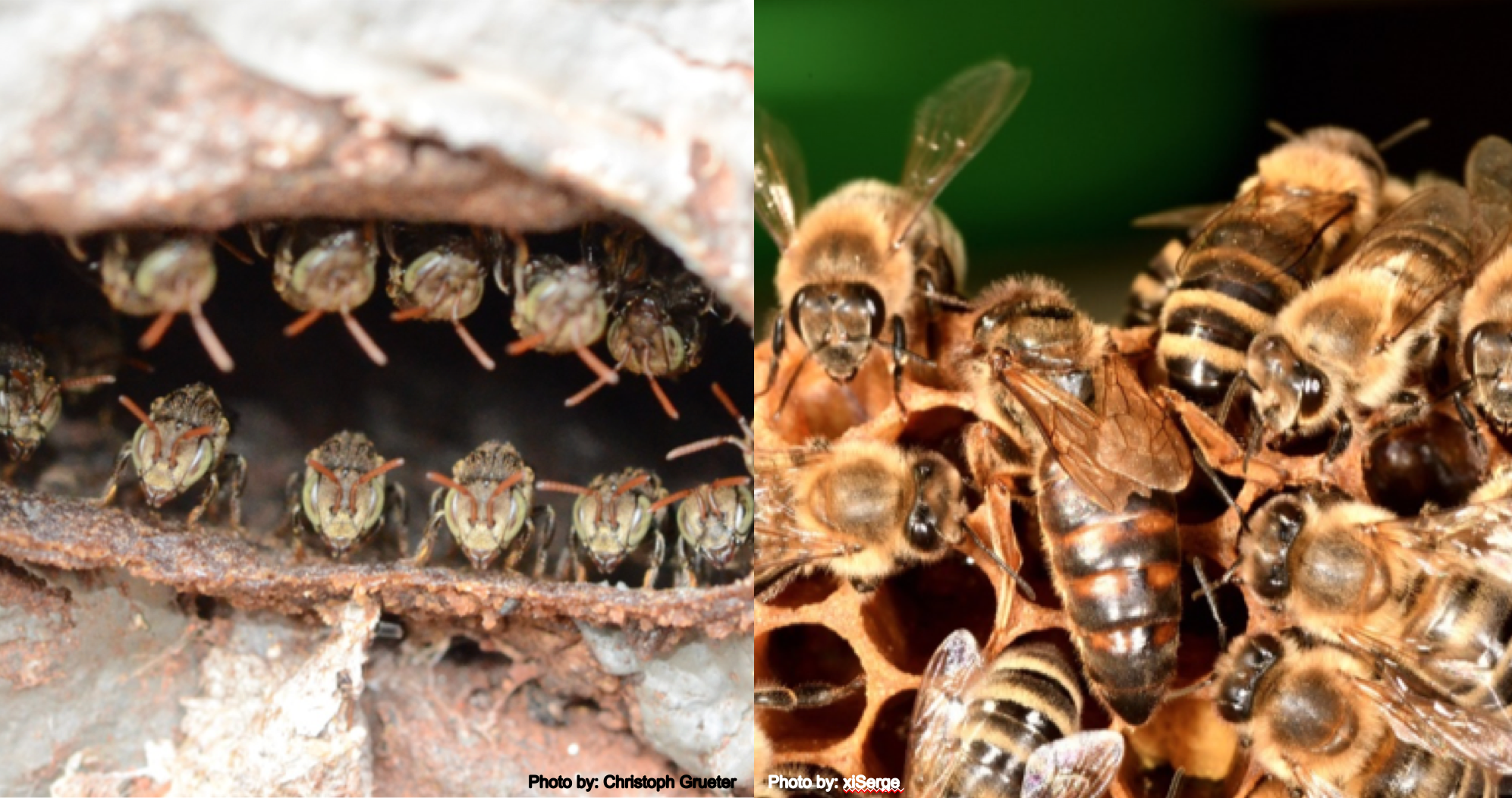Ever wondered what are the main differences between honeybees and stingless bees? Besides the colours and sizes, many characteristics are imperceptible just by looking at them, such as how their nests are organised and behavioural traits.
Author: Ana Paula Cipriano
Leia em português.
Honeybees and stingless bees share important characteristics, such as colonies with many individuals, that can live for several years. However, while there are 10 species of honeybees, stingless bees are an extremely diversified group, with more than 550 species.
Within stingless bee hives, the cells with food supplies and brood have different shapes and sizes and are distributed in distinct places, so we could say they have their kitchen area and an incubation area for new bees. In honeybee colonies the structure is different, they build identical cells for storing food and their eggs, except for male bees, which have bigger cells. A remarkable characteristic also related to building the nest is that honeybees can reutilize old brood cells, while stingless bees always build new ones.

Honeybees in a comb. Picture by xiSerge
An interesting point that also differentiates honeybees and stingless bees is the behaviour of the queens when initiating a new nest. Honeybees queens fly to start a new hive, while the virgin queen stays in the established nest, and the opposite situation occurs with stingless bees. Talking about the queen, stingless bee queens usually just mate with one male, while honeybee queens can reproduce with several males, a great difference related to colonies’ genetics, for example.
But how do eggs become queens or workers in both groups? There are different ways, and they can be related to nutrition and genetics, but basically, stingless bee queens receive more food than workers during larval development, while honeybee queens also receive more food, however, the food is also different from the workers, these queens receive a very special banquet.
Talking about the workers, honeybees use their sting to protect their hives, but stingless bees have different strategies. Despite the small size of some species, they are far from being defenceless, and guards can use their strong mandibles to bite and some species can release acid on enemies. Even tiny stingless bee workers can be very bold and attack honeybees when they feel the need to protect the nest or resources.

The stingless bees Nannotrigona testaceicornis at the nest entrance. Picture by Christoph Grüter.
Workers in both groups of social bees share general tasks, as mentioned before, they protect the hives, but also collect food, take care of the brood, build different structures, and clean the hives, so they have a huge “to-do list”. However, some of these behaviours are different depending on the species. Stingless bee uses their own hives as their “toilet”, storing waste and then disposing of it outside the nest. While honeybees defecate outside their hives. Another interesting difference lies in reproduction, stingless bee workers may produce males for their hives, while in honeybees they are usually sterile.
Lastly, honeybees are known worldwide for their amazing dance, the “waggle dance”, that workers use to communicate where to find good food sources. These organized movements that foragers perform inside the nest can guide other bees to flowers and increase their food intake! Stingless bees also have strategies to inform where the good resources are, however, they can be very different among species, with some of them depositing odours to make a trail and guide nestmates.
Honeybees and stingless bees, therefore, are not just different because of their stings or body size. Their hive organization and individual behaviours can be completely different, and that is one of the beauties of investigating more of this amazing world of social bees.
Bibliography
Grüter, Christoph. Stingless bees: their behaviour, ecology and evolution. Springer Nature, 2020.
Your donation can have a positive impact on the world!
Subscribe to receive our Newsletter!
Find us also at Linkedin, Facebook, Twitter or Instagram
www.meli-bees.org
❤️


One Reply to “Honeybees and stingless bees: what are the main differences between these two great pollinator groups?”